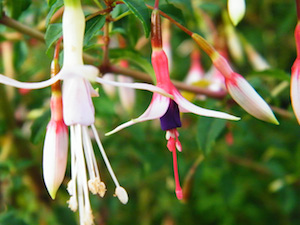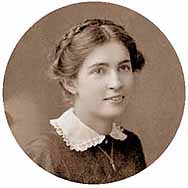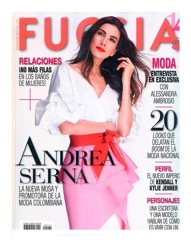
Want to know what those mysterious terms mean and just who the people were behind those names? Then this is the place for you.
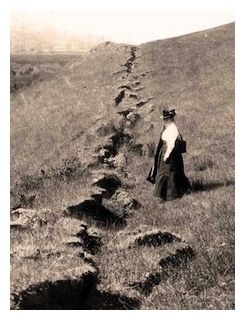
Ignoring the destruction of her own home and loss of most of her possessions, Eastwood heroically saved the Academy's type plant collection after the 1906 San Francisco earthquake. She had segregated the type specimens from the main collection and, while much was lost, this system permitted her to retrieve about 1500 of the invaluable type specimens from the burning Academy building in short time to take them to safety.
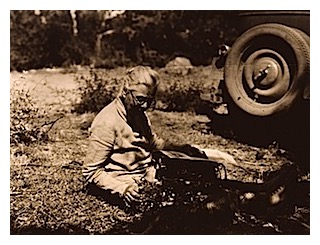
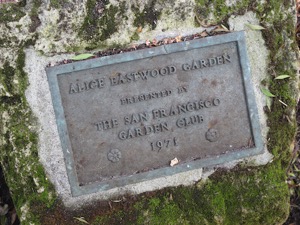
(Illustrations: 1. Eastwood viewing a rift in the Olema Valley north of San Francisco caused by the 1906 earthquake. G. K. Gilbert, U. S. Geological Survey, 1906; 2. Sorting botanical specimens in the field in 1929, the year she helped found the American Fuchsia Society. MSS. 142, Alice Eastwood Papers, California Academy of Sciences Archives, San Francisco, Calif.)
Eburnea – Ivory white. A pale-flowered selection of F. magellanica described as F. magellanica var. eburnea (Pisano 1979). This designation, however, no longer has any taxonomic status and should now only be written as F. magellanica 'Eburnea.' F. magellanica 'Alba' (Clarence Elliot 1932) and 'Molinae' (Espinoza 1929) are two further, even more pale-flowered horticultural selections that are also synonyms for F. magellanica. Of unknown origin, F. magellanica 'Lady Bacon' is a seemingly identical selection to F. magellanica 'Eburna'. See also ➤ Alba for more details.

Edibility – Fuchsias are not toxic to humans and all parts are edible, from the berries to the flowers, or even the leaves.
The berries of several Fuchsia species are especially relished. These include Fuchsia boliviana (regularly eaten by native peoples in the Andes), F. excorticata (traditionally eaten by the Maori who called the berries Konini) and F. magellanica (first eaten in Chile and Argentina by the Mapuche and other native peoples, but still widely consumed throughout their natural range.). The elongated berries of F. splendens are also considered tasty by connoisseurs.
The taste is variously described as lemony or peppery and has a pleasing sub-acid quality. The berries on most cultivars, however, varies considerably in their taste as most were bred for the look of their ornamental flowers rather than their berries. Fuchsia berries are said to be high in Vitamin C and antioxidants. They’re eaten fresh or used in recipes such as jellies, jams and puddings. A common problem with cooking with the berries is simply collecting enough of them from the typical garden to be useful. See Recipes.
Fuchsia flower are edible, as well, and can used as a floral garnish in salads and elsewhere. Scientific studies have shown that the flowers are high in anthocyanins, the group of compounds that give these flowers their red and blue coloration. Anthocyanins are strong antioxidants and further studies need to be undertaken to determine the precise health benefits eating fuchsia flowers might have as part of a diet.
See ➤ Scientific Bibliography.
Elegans – Elegant. F. elegans (Salisb. 1791) is a synonym of F. coccinea (Aiton 1789) in ➤ Section Quelusia.
Elliptic – Shaped like an ellipse or oval. The term is applied to fuchsia leaves with this general outline.
Ellobium – From the Greek ellobion, or earring. Ellobium fulgens (Lilja 1841) is synonymous with F. fulgens (De Candolle 1828). It had previously been transferred from another now invalid genus, Spachia fulgens (Lilja 1840), before finally being settled back in Fuchsia. The name was later revived for the Ellobium section of the genus, however (Breedlove, Berry, Raven 1982). See F. fulgens in ➤ Section Ellobium; Fulgens; Spachia.
Encliandra – From the Greek for "enclosed male," referring to the fact that the flower's stamens are enclosed within the floral tube. Encliandra parviflora (Zuccarini 1837) in now synonymous with F. encliandra (Steudel 1840). See F. encliandra in ➤ Section Encliandra, of which there are three recognized subspecies.
Encliandras – The ➤ Encliandra Section species, as well as their hybrids, characterized by similar miniature flowers and the same general lacy-leaf effect of the foliage characteristic of the plants in the section. Some typical Encliandra hybrids are 'Cherry Pop', 'Irish Cup' and 'Lottie Hobbie'.
Endemic – Unique to a specific geographic area.
Entire – A leaf margin or edge that is smooth and untoothed; without notches or indentations. F. arborescens, for example, has leaves with entire margins.
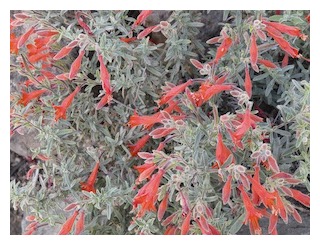
(Illustration: Epilobium canum, or the California Fuchsia.)
Epiphyte – A plant that grows on another plant, such as a tree, or on other surface, such as on a rock, in a non-parasitical manner and gets its moisture and nutrients from rain and accumulated organic debris. A number of fuchsias, such as f. fulgens or F. apetala, can sometimes be found growing as epiphytes on trees or rocks as well as in the ground.
Eufuchsia – From the prefix eu, meaning good or well, plus Fuchsia. Former name and synonym of ➤ Section Fuchsia. The change of this section's name to Fuchsia was necessarily made to reflect the fact that the type species of the genus, F. triphylla, is in the section.
Euro-Fuchsia (1984-2022) – An former association of European fuchsia societies founded in 1984 when several national societies joined forces with the goal of encouraging cooperation and exchanging information on the culture and propagation of fuchsias across Europe. The Society was formally folded in July, 2022. There were fourteen member societies, with a combined membership of about ten thousand, and the association meet annually. In 2011, Euro-Fuchsia updated its constitution to include smaller societies and internet fuchsia groups, as well as individual members. While its attention remained focused on Europe, membership was open to non-European groups as well. In its final years, Euro-Fuchsia lost two long-standing members when the Swedish Fuchsia Society permanently folded and the British Fuchsia Society withdrew due to the difficulty in attending meetings, as well as the flagging interest of its own members. These losses helped contribute to the eventual demise of the organization.
➤ Euro-Fuchsia.
Evening Primrose Family – See ➤ Onagraceae.
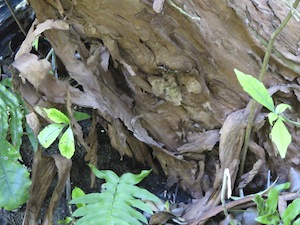
Excorticata – Stripped of bark; having its bark hanging away. F. excorticata, the native tree fuchsia or kōtukutuku of New Zealand, was named for the very distinctive appearance of its bark but other fuchsia species also exhibit the characteriostic tendency of having papery strips of bark flaking or hanging away to greater or lesser degrees. On F. excorticata, the resulting mottled patterning on portions of its large tree-sized trunks and branches can also be especially attractive. This species is the largest of the Fuchsia genus, sometimes reaching to a height of fifteen meters (fifty feet), and is found throughout New Zealand to the Auckland Islands, almost three hundred miles south of South Island (465 kilometers). It is unusual among New Zealand trees for being deciduous in the southern parts of its native range. See F. excorticata (G.Forst., L.f. 1782) in ➤ Section Skinnera. Skinnera excorticata (J.R. Forst. & G. Forst. 1776) is a synonym of this species.
(Illustrations: 1. Fuchsia excorticata (Forster f.) L.f. Botanical Register, vol. 10: t. 857 (1824) [M. Hart]; 2. Base of the trunk of F. excorticata showing strips of bark hanging away.)
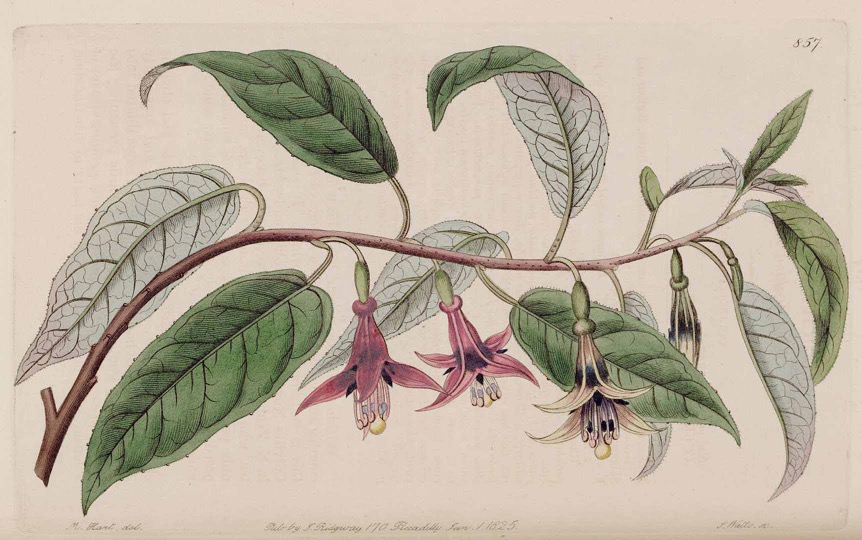
Exoniensis – From Exeter in England. F. exoniensis or F. x exoniensis (Paxton 1843) is an inlaid taxonomic synonym of a horticultural selection or likely garden hybrid of F. magellanica (Lam. 1788). Today the name should be rendered as F. magellanica 'Exoniensis' to indicate its origin in cultivation.
Experscandens – F experscandens or F. × experscandens (Allan 1927) is an unresolved name published by H. H. Allan in "Illustrations of Wild Hybrids in the New Zealand Flora," Genetica: A Journal of Genetics and Evolution, Volume 9, Issue 4-6, July 1927, p. 507. It seems to represent a possible natural hybrid with F. perscandens.
Fan – A fuchsia that have been trained into a flat, espaliered shape that resembles the classic outline of an opened folding fan. Training starts with the selection of shoot with four or five sets of leaves. The side shoots are directed into a fan shape, usually with the help of supports, and then stopped at six or seven sets of leaves, and the next set of side shoots at two or three sets of leaves. The topmost, however, is left to grow as a repeat of the original shoot. The process is continued until the desired size of the fan has been reached.
Fasciation – Also called cresting, fasciation is a relatively rare phenomenon of abnormal growth seen in fuchsias and other vascular plants. The growing tip, or apical meristem, of vascular plants is normally concentrated around a single point and normally produces cylindrical tissue. In fasciation, the growing tip becomes elongated perpendicularly to the direction of its growth, and produces flattened, ribbon-like, or elaborately contorted and waved tissue, hence the name cresting.
Fashion Fuchsia – Hollywood cerise or simply Hollywood, a bright pink or magenta color used in the fashion industry, is sometimes referred to as fashion fuchsia. Its hex triplet code for HTML programming is #F400A1. See also ➤ Color Fuchsia.
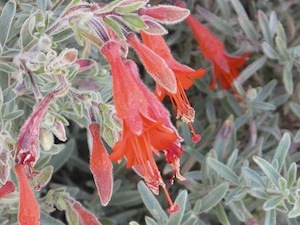
(Ilustration: Epilobium canum, or the California Fuchsia.)
Ferreyra Huerta, Ramón (1910-2005) – Peruvian botanist, environmentalist, plant collector, and professor at the

Ferreyrae – Named in honor of Ramón Ferreyra (1910-2005). The new species as described was collected in 1978 by Paul Berry and James Aronson on the road to Concepción in the Janín Department of Satipo Province in Peru. See ➤ Ferreyra; F. ferreyrae (Berry 1982) in ➤ Section Fuchsia. No synonyms of this species are recorded.

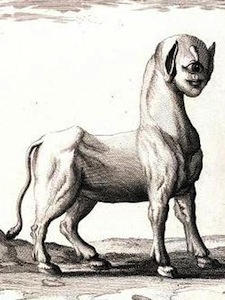
Field Techniques – Methods used in the collection and preparation of botanical specimens while in the field or on plant-hunting expeditions. For an excellent set of recommendations for high-quality results, see this handbook from the ➤ Missouri Botanical Garden.
Fierce Fuchsia – A poem by Erlin Aprilia Efendi which begins, "Out there the pink comes up, Undeniable its heart is numb, The real comes in the end, The first is just for heaven; Inside here the purple appears, It shows its calyx then consoles quite clear…" The poet seems otherwise unknown in English. It is possible that the work represents a single submission of otherwise unpublished material to the Poem Hunter website. It might also represent an unique translation from another language. See ➤ Fierce Fuchsia.
Filament – The stalk portion of the stamen. The pollen-producing sac, the anther, is located at its end. In fuchsias, the protruding and variously colored filaments often add significantly to the decorative effect of the flowers.
Filipes – Having thread-like stalks. F. filipes (Rusby 1927) is a synonym of F. sanctae-rosae (Kuntze 1898) in ➤ Section Fuchsia.
Final Pinch or Stop – The last removal of a fuchsia's growing tips before the plant is left to flower. Flowering can usually occur anywhere from eight to twelve weeks after the final stop depending on the cultivar. The timing of the last stop is especially important when preparing the floral display of a particular cultivar to be at its peak for a flower show.

It's been suggested that the colorful story was an invention to cover the questionable liberation of cuttings from the royal botanical collection at Kew. That explanation is very unlikely, however (see ➤ Lee). The Tale of the Windowsill first surfaces well after the brief citation of Firth in the Hortus Kewensis and it becomes embroidered with increasing detail and sentiment, even to the point of melodrama, as time goes on. Even Charles Dickens has a go at the story in his journal, Household Words, published from 1850-1859.
A fuchsia is indeed listed as being grown at Kew in the 1789 catalogue, the Hortus Kewensis, and Captain Firth is stated as its source. Called Fuchsia coccinea, the new acquisition is obviously confused with F. magellanica (Lamarck 1788), a species with a similar flower, since reference is made to Feuillée's thilco (see also) and it's noted, "Native of Chili. Introd. 1788, Captain Firth."
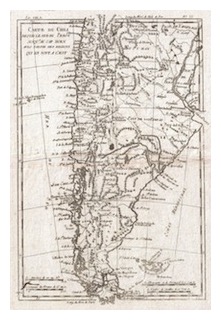
Nonetheless, a real amount of mystery remains behind the plant at Kew. The calyx of F. magellanica is certainly often scarlet and there's much public confusion at this early period between the two names, if not the two species. F. magellanica is also very variable across its native range, which can additionally blur identification. In early references, it's quite impossible to tell which species is really which. F. coccinea may have been described first in England but the question remains, "When did the much more widely grown and hardy F. magellanica enter English gardens?"
To make matters just slightly more confusing, neither was even the first fuchsia recorded as being grown in England. About 1730, ➤ Phillip Miller, the head gardener at the Chelsea Physic Garden, received seeds shipped from "Carthagena in New Spain" from fellow Scotsman and botanist ➤ William Houstoun. That fuchsia, arguably identified as F. triphylla, was apparently successfully grown there for a number of years before it disappeared from cultivation. Since Miller was head gardener at Chelsea from 1722 to 1771, it's unclear at what date that first fuchsia was lost. Most importantly, however, Houston's fuchsia was apparently never cultivated except at Chelsea by Miller before it was lost. It was either F. coccinea or F. magellanica that would first enter general English horticulture. But which one, though?
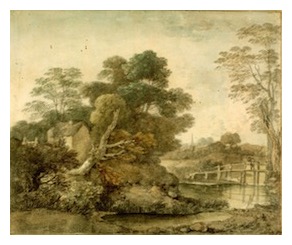
It's also winter hardy enough to have thrived outdoors in many places in the British Isles, unnoticed and unrecorded by the botanical establishment in London, for many decades before it suddenly burst onto the fashionable garden scene in the 1790's or later. It was much hardier than the competition, in fact, in spite of contemporary misconceptions of F. magellanica as a tender plant, an indication again of its confusion with F. coccinea. While the real F. coccinea was mostly confined to overwintering in hothouses with stoves, it's certainly F. magellanica and its hybrids, perhaps even with F. coccinea, that were to become so widely naturalized in favorable regions all over the British Isles today.
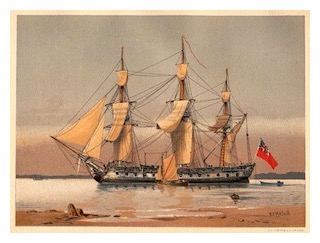
Officers of British vessels, both royal and merchant, were explicitly expected to be on the look-out for anything that might prove useful or interesting to Britain and return home with samples or reports. Kew was, of course, the frequent recipient of many botanical novelties. As was also the Chelsea Physic Garden. And sailors did often return from their long journeys with exotic gifts and souvenirs for their friends and family.
See also ➤ Handisyd; ➤ Miller; ➤ Sloane.
(Illustrations: 1. Suggested portrait of the mysterious Captain Firth; 2. Rigobert Bonne & Guillaume Raynal, Carte du Chili depuis le sud du Pérou jusqu'au Cap Horn avec partie des regions qui en sont à l'est, Atlas de Toutes les Parties Connues du Globe Terrestre, 1780; 3. Landscape with Cottage, Thomas Gainsborough, ca. 1780; 4. a British frigate, W.F. Mitchell, 1780.)
Fischer, Paul – Swiss photographer who aided ➤ J. Francis Macbride
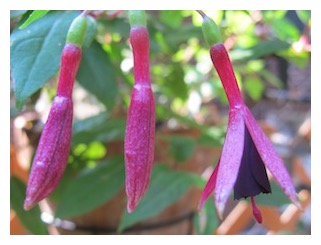
Fischerii – Named in honor of Paul Fischer. F. fischerii (Macbride 1941) is a synonym of F. mathewsii (Macbride 1940). See ➤ Fischer; ➤ Mathews; and F. mathewsii in ➤ Section Fuchsia.
Flexuous – Winding from side to side; sinuous.
Flor de arete – Earring flower (Spanish); ➤ common name for the fuchsia in some parts of Latin America.
Flor de nácar – Nacre or mother-of-pearl flower (Spanish); common name sometimes incorrectly used for the fuchsia in some parts of Latin America. As the descriptive name suggests, Flor de nácar is more properly applied to Hoya carnosa, or the wax plant.
Floriferous – Flowering freely; bearing many flowers.
Flower Bud – The developing and unopened blossom. In fuchsias, the differing shapes and colors of flower buds just before they open are a defining characteristic of many cultivars and often very useful in determining the identity of unknown plants.
(Illustration: Fuchsia 'Zulu King'.)
Foliar Feeding – Sprays or mists containing mild solutions of nutrients are often applied topically to be absorbed directly through the plant's leaves rather than through its roots. Fuchsias respond well to foliar feeding but care should be taken to make sure that the solution used is not so strong as possibly to burn delicate leaves and shoots.
Fontinalis – From fountains or springs. See F. fontinalis (J.F.Macbr. 1940) in ➤ Section Fuchsia. No synonyms are recorded for this species.
Form or Forma – (Plural: forms or formae) In taxonomy, a form is an infraspecific category below a variety (see also), indicating a noticeable but minor deviation. The designation is often considered unnecessary by botanists as there can be almost countless forms based on very minor genetic differences.
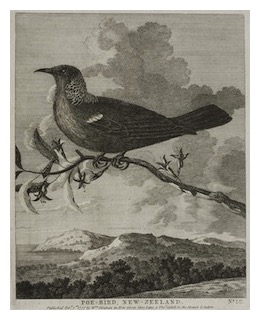
(Illustration: Poe-Bird, New Zealand. James Cook, A Voyage Towards the South Pole, and Round the World, 1777. This plate shows the poe-bird perched on a flowering branch of Skinnera excorticata (now Fuchsia excorticata) and is one of five botanical illustrations in the book taken from the Forsters. These plates were not attributed to the Forsters due to a dispute with Cook and the Admiralty over the joint authorship of the expedition's journal.)
Fosbergii – Fuchsia fosbergii was named in honor of the distinguished American botanist, F. Raymond Fosberg (1908-1993). The species is now a synonym of F. harlingii (Munz 1972) in ➤ Section Fuchsia.
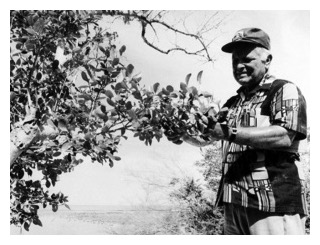
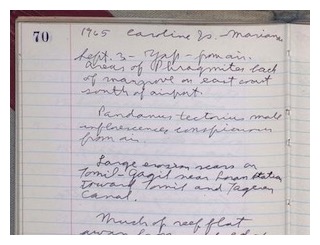
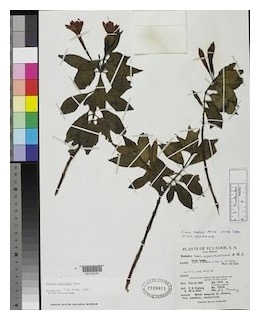
(Illustration: 1. Detail of F. Raymond Fosberg in the field. Kjell Bloch Sandved, Smithsonian Archives, 92-1712; 2. Detail of an entry in one of Fosberg's notebooks. 3. Isotype of F. fosbergii, now a synonym of F. harlingii, preserved at the Smithsonian's National Herbarium.)
Fossil-Taxon – According to the Vienna Code (McNeill, Barrie & Burdet 2006), any plant taxon whose type is a fossil is referred to as a fossil-taxon. Fossil-taxa can be a particular part of a plant preserved in a particular way, as defined in the diagnosis. Otherwise, the names of fossil-taxa follow the same regulations as does the nomenclature of living plants. As with living plants, fossil names are fixed to a type specimen. Competing names are accepted according to the chronological priority of first publication, as well. Until recently, there were no fossil-taxa of Fuchsia. That changed with the discovery a fossil flower and an associated anther clump preserved in early Miocene limestone from New Zealand. This new fossil-taxon was published as Fuchsia antiqua in October 2013. ➤ Antiqua.
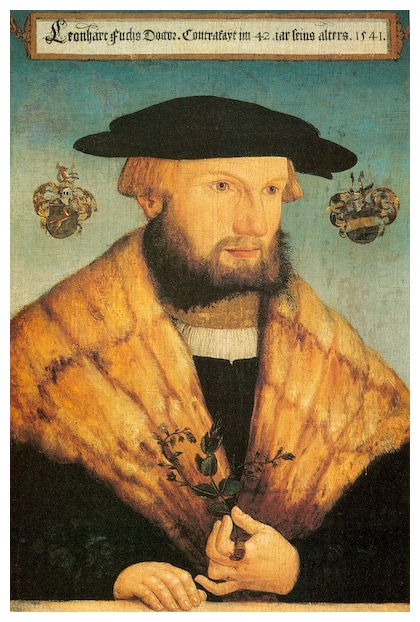
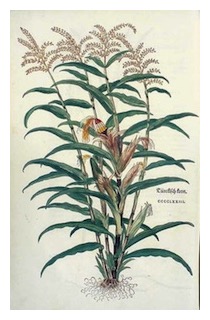
Fuchsia (m.) – In French, le fuchsia is a masculine noun. At the beginning of the 19th century, la fuchsia (f.) was common in French but this later changed, possibly to reflect that the genus was named to honor Leonhart Fuchs and Fuchsia might be considered a masculine noun of the first declension in botanical Latin. Other plants, such as le begonia, are similarly constructed. In some early publications, the linguistically modified word Fuchsie may be found in sections of French text in opposition to the scientific name Fuchsia used in the Latin descriptions.
Fuchsia Sw. – See Fuchsia involucrata Sw.
The Fuchsia (Poem) - The Fuchsia is a poem by American poet Matty Reynolds (b. 1973) which begins, "I want to buy you, A fuchsia to hang, My heart from…" ➤ The Fuchsia.
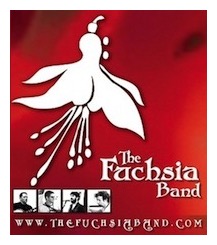
The Fuchsia Band (Music group) – An Irish folk music group from Cork, Ireland. The Fuchsia Band's four members are Brian McGillicuddy, Máirtin de Cógáin, Eoin Verling and Michael Hefferman and their energetic performances feature traditional Irish music, story, song and dance. See ➤ band website.
(Illustration: Poster advertising The Fuchsia Band.)
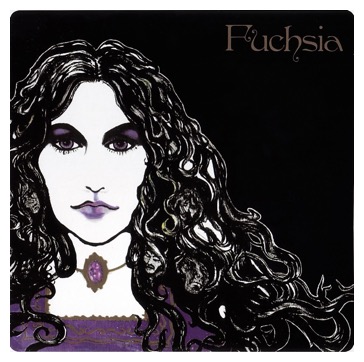
Fuchsia Begonia – Begonia fuchsioides. See ➤ Faux Fuchsias entry; also ➤ Faux Fuchsias page.
Fuchsia Bush, Fuchsia Emu Bush – Common name for the Australian native, Eremophila maculata, in its home country. It's also occasionally called "Wild Fuchsia" in Austrailia. See ➤ Faux Fuchsias entry; also ➤ Faux Fuchsias page.
Fuchsia City (Video game) – Japanese セキチクシティ or Sekichiku City. A location within the popular video game series, Pokémon, published by Nintendo. Fuchsia City refers to the color magenta and not to the plants.

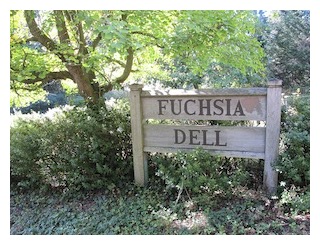
Fuchsia Dunlop (Personal name) – See ➤ Fuchsia (Personal Names).
Fuchsia (Film) – Title of a 2009 Filipino drama-comedy film. Fuchsia was directed by Joel Lamangan and stars Eddie Garcia, Robert Arevalo and the popular Filipino-American actress, Gloria Romero, as Mameng, an older but still hip woman who adores the color fuchsia and must deal with her aging relatives.
A Fuchsia Elephant (Short Film) – Title of a still-unreleased comedic short film (running time 10 min.) from 2009, written, directed and starring Dianna Agron. Argon is best known for her portrayal of the high school cheerleader, Quinn Fabray, from 2009-2014 on the popular FOX television series Glee. As Charlotte Hill, she makes the decision just before her eighteenth birthday not follow in the footsteps of an alcoholic mother. Enlisting the help of Michael (Dave Franco, producer of the film and younger brother of James Franco) and her other friends, Charlotte recreates the fun-filled eighth birthday party she never had, complete with pirates, gypsies and a bright fuchsia-colored elephant.

uchsia Fairy – A drawing done by the English illustrator, Cicely Mary Barker (1895-1973), who was especially popular for her many fantasy illustrations, published in numerous books, depicting English garden and wildflowers as fairies. In 1934, the Fuchsia Fairy illustrated the letter F in Flower Fairy Alphabet. In the original publication, each letter is accompanied by a short poem. Today, the Fuchsia Fairy (along with most other Barker illustrations) is found reproduced on innumerable articles of merchandise, from plastic hanging ornaments to porcelain plates and everything conceivable monetizable thing in between. There are a number of more recent imitations of Flower Fairies but almost all lack the charm and immediacy of Barker's work and generally tend to sexualize the subject.
The Song of the Fuchsia Fairy
Fuchsia is a dancer
Dancing on her toes
Clad in red and purple
By a cottage wall;
Sometimes in a greenhouse,
In frilly white and rose,
Dressed in her best for the fairies' evening ball!
Fuchsia Flash – Quarterly newsletter of the ➤ Northwest Fuchsia Society (USA).
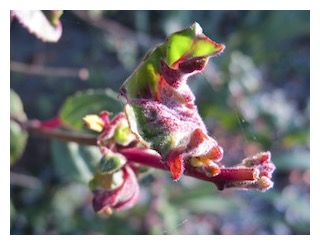
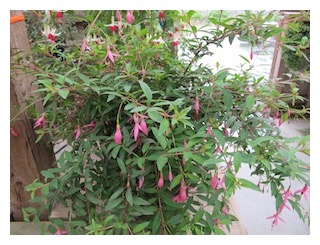
(Illustration: 1, Fuchsia gall mite damage on 'Swingtime'; 2. 'Del Campo,' a gall mite resistant cultivar developed by Peter Baye at the Strybing Arboretum.)
Fuchsia Groan – Fuchsia Groan is the name of a fictional character in Mervyn Peake's novels Titus Groan (1946) and Gormenghast (1950). She is the daughter of Sepulchrave, the 76th Earl of Groan. The character was played by Scottish actress Neve McIntosh (b. 1972) in a BBC film adaptation in 2000. Fuchsia Groan is also the subject of song by the rock band, The Cure, called The Drowning Man.
Fuchsia Hedges in Connacht (Poem) – A poem by the Irish poet, Padraic Colum (1881-1972), which begins, "I think some saint of Eirinn wandering far, found you and brought you here Demoiselles! For so I greet you in this alien air…" As well as a poet, Colum was a celebrated novelist, dramatist, biographer, playwright, children's author and collector of folklore and is considered one of the leading figures of the Irish Literary Revival. ➤ Fuchsia Hedges in Connacht.
Fuchsia in all the Languages of the World – Since Linnaeus introduced the binomial system of plant classification, the correct scientific name of the genus is always Fuchsia. This denomination from botanical Latin also often serves as a common name. However, many languages have quite different orthographic and linguistic rules than are found in English and must necessarily alter the spelling or pronunciation outside of scientific use. In languages that don't use the Latin alphabet, there is additionally the often awkward or difficult attempt at a phonetic transliteration. However, not all sounds found in Latin are to be found in all languages and, when no exactly corresponding letters are available, the equivalence must be shifted slightly or significantly. Or perhaps even an evocative new name created. Chinese is a good example. Because that language's written characters are based on logograms and not a phonetic alphabet, the colorful new name of the "Hanging Lantern Flower" has come into being among Chinese speakers and readers.

- Arabic - ضارب الى الحمرة
- Armenian - գոյական փուքսենի
- Azerbaijani - Küpəçiçəyi
- Basque - Fuksia
- Belarusian - Фуксія (Fuksiya)
- Bosnian – Fuksija
- Bulgarian - Обичка (Obychka)
- Breton - Fuchia; also kleierigoù-ruz or kloc'higoù-ruz
- Catalan – Fúcsia
- Chinese - 吊灯花: Diàodēnghuā or Hanging Lantern Flower;
倒挂金钟: Zhonghai Tang or Hanging Fuchsia Begonia Lantern;
晚樱科植物: Wǎnyīnɡkēzhíwù or Late Cherry Plants. - Croatian – Fuksija
- Czech – Fuchsie
- Danish – Fuchsia
- Esperanto - Fuksio
- Estonian – Fuksia
- Finnish - Fuksia; also Verenpisarat
- Galician – Fúcsia
- Georgian - ფუქსია (Puqsia)
- German – Fuchsie
- Greek - Φουξία (Phoysia)
- Hebrew - פוקסיה (Foksih)
- Hawaiian - Kulapepeiao
- Hindi – फ़ूशिया (Phūhaṛa)
- Hungarian – Fukszia
- Icelandic – Fuchsia
- Ido - Fuxio
- Irish - Fiúsie; Deora Dé (God’s Tears)
- Italian - Fucsia
- Japanese –フクシア( Fukushia)
- Khmer - Fuchsia
- Korean - 푸크시아 (Pukeusiah)
- Latin - Fuchsia
- Latvian – Fuksija
- Limburgian - Foksia
- ithuanian – Fuksija
- Macedonian – Обичка (Obička)
- Malayalam - ഫ്യൂഷിയ
- Maori - Kōtukutuku
- Maltese - Fuxa
- Manx - Thammag vineenagh, jeiryn yee
- Marathi - खाली लोंबणार्या सुंदर फुलांचे झाड
- Mongolian - Fuchsia
- Nepali - फुच्सिया
- Norwegain - Fuksia; also Tårer
- Persian - گل گوشواره
- Philipino - Pusiya
- Polish – Fuksja; also ułanka
- Portuguese – Fúcsia; also brinco-de-princessa, bochechudo, mimo
- Priulian - Fucsia
- Quechua (Inca) - Chiyu
- Romanian – Fucsie, cerceluş
- Russian – Фуксия (Fuksiya)
- Serbian – Фуксија (Fuksija)
- Sesotho - Monjet
- Slovak – Fuchsie
- Slovenian - Fuksija
- Spanish – Fucsia; also pendientes de la reina, chilco, aljaba
- Swedish – Fuchsia; also fuchsiasläktet
- Tajik - Гуловез
- Thai - โคมญี่ปุ่น
- Tibetan - མངར་དྲིལ།
- Turkish - Küpe çiçeği or Küpeçiçeği
- Ukranian - Фуксія (Fuksiya)
- Urdu - فشیا
- Uzbek - Fuşya
- Vietnamese - Cây khoa vản anh
- Welsh - Ffiwsia; also dropys cochion
- Yiddish – פוטשסיאַ
- Zulu - Uhlobo lwembali
(Illustration: Brueghel's Tower of Babel, 1563.)
Fuchsia involucrata Sw. – A synonym of Schradera involucrata (Sw.) K.Schum (Fl. Bras. 6(6): 295 1889), belonging to a genus of flowering plants in the Rubiaceae first described by Martin Vahl in 1797. The genus has a wide distribution from tropical America to the Malay Archipelago. Olof Peter Swartz (1760–1818) was a Swedish botanist best known for his taxonomic work and studies of pteridophytes.
The Fuchsia is Now (Book) – Illustrated children's book by J. Otto Seibold published in 2006. The simple story features Fuchsia who receives a pink hat, which makes her look somewhat like the flower, as a birthday surprise from her small friends. The hat contains a fairy who grants her wishes when she repeats the title phrase, "The fuchsia is now". The book is intended for very young children between the ages of three and five. Seibold is also the primary illustrator and co-author of several other children's books, such as Olive, My Love.
➤ The Fuchsia is Now.
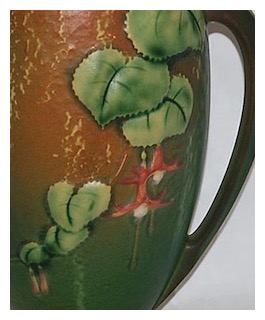
Fuchsia (Misspellings) – Because of the elided pronunciation of fuchsia in English, misspellings are common. In fact, it's probably one of the most misspelled words in the English language. Beside the commonly seen fuschia, some other notable miscreants include fushia, fuchia, fuchuia, fuscia, fucsia, fiusha, fusha, fucha, fewsha, fcusia and quite a few more.
Fuchsia OS – Code name for a new computer operating system apparently being developed by internet search giant, Google (as of August 2016). The OS is being said to run on any device. If the troubled mess of the Android operating systems for mobile devices is any indication of Google’s success, poor fuchsia with be in for a rough start in a hackers’ garden and playground. Perhaps bindweed might have been a better codename. If you do use “fuchsia” as a search term on Google’s core business, be aware that Bing actually returns better and more focused results. Google puts too much weight into the overall web of links, to the detriment of the actual quality of the content, and it shows in the misplaced rankings of popular but generic or superficial sites. Lilian Vernon may be well-linked, but the company is hardly an expert on anything, let alone fuchsias.
Fuchsia (Personal Names) – Due to the popularity of the flower–and the word's association with the vibrant pink-purple color magenta–Fuchsia has occasionally been adopted as an especially female forename both in fiction and in reality. For example, Fuchsia Groan appears as the name of a fictional character in Mervyn Peake's novels Titus Groan (1946) and Gormenghast (1950). A prominent example from real life is Fuchsia Dunlop, an English writer and chef specializing in Chinese cuisine. In another instance, the British musician, Sting (Gordan Summer, b. 1951), and his first wife, the actress Frances Tornelty (b. 1948) named their second child "Fuchsia Catherine" in 1982.
Fuchsia Research International – A organization based in the United Kingdom that was dedicated to the study and research of fuchsia species. FRI published the Journal of Fuchsia Research and maintained the National Collection of Fuchsia Species at Margham Park. It was dissolved in 2008 and its plant collection transferred to the Arboretum de Chèvreloup at Versailles for preservation.
Fuchsia Rust – Pucciniastrum epilobii. Fuchsia rust is the most serious disease that might affect fuchsias. It alternates its cycle between the willowherb or fireweed, (Epilobium angustifolium but now Chameron angustifolium), a close relation to the fuchsia, and the fir tree (Abies). Spores can travel distances on the wind and outbreaks generally occur late in the season. Rust is difficult to control once it's established so it's generally recommended to regularly monitor plants for the characteristic orange pustules and pick off infected leaves, if in rust prone areas with firs and fireweed, and then spray with an appropriate fungicide, such as Bayleton's. The disease will easily carry into the next year if plants are not properly treated before winter.
Fuchsia Singers (Music group) – An a cappella choir of five singers based in London. An album of their music, The Voice Collection, was released on 2013. ➤ Fuchsia Singers.
Fuchsia (Sinfest) – A character in the webcomic, ➤ Sinfest, started by American artist Tatsya Ishida. Fuchsia is described as "Previously a stereotypical succubus. [She] fell in love with the kind-hearted Criminy and quit her job to pursue a normal life. Enjoys painting but suffers flashbacks about her previous employment."
Fuchsia Societies – See ➤ Fuchsia Societies webpage for a full list.
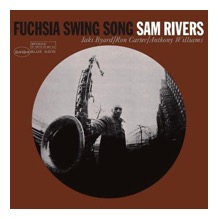
Fuchsiaceae – Invalid plant family. The genus Fuchsia belongs to the Onagraceae, or Evening Primrose Family. Fuchsiaceae was created by the Swedish botanist and man of letters, Nils Lilja (1808-1870), in the substantially reworked second edition of his Skånes flora (Flora of Scania, 1838) released in 1870. The colorful Lilja also had a penchant for creating new genera out of old fuchsias. See ➤ Lilja.
Fuchsiaeflora – See ➤ Fuchsiiflora.
Fuchsian Group – Nothing to do with fuchsias at all. It's simply a geometry term for any discrete group of isometries of the hyperbolic plane.
Fuchsiana – 1. Things related to fuchsias; 2. ➤ Fuchsia lore; 3. The name of the bimonthly publication of the Nederlandse Kring van Fuchsiavrienden.
Fuchsiarama – This amusingly named fuchsia nursery was once located in Fort Bragg, California, on the scenic California Highway 1. It specialized in hardy and heat-resistant cultivars suited to the California climate, especially the hot, dry areas away from the coast. The nursery was suddenly closed in 2010.
Fuchsias in the City – Former name of The Fuchsietum when it was based in Manhattan from 2010-2019.
Fuchsie (f.), Fuchsien (pl.) – German for fuchsia.
Fuchsii – Named in honor of Fuchs, usually meaning ➤ Leonart Fuchs. Plants with this species designation, such as the bromeliad, Tillandsia fuchsii, or the common spotted lily, Dactylorhiza fuchsii, have nothing to do with the genus Fuchsia. Both epithets are simply derived from the same German surname.
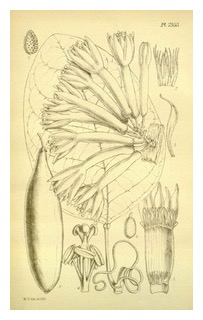
(Illustration: Passiflora fuchsiiflora. Matilda Smith (1854–1926), Hooker’s Icones Plantarum, 1898, vol. 26, table 2553).
Fuchsiifolia – Having leaves resembling those of the genus Fuchsia. A notable example is Cuphea fuchsiifolia (A.St.-Hil. 1833), a plant native to Brazil in the Lythraceae or Loosestrife Family.
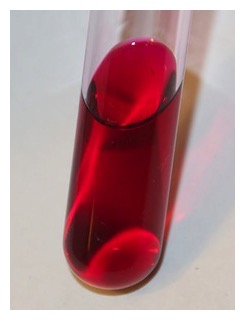
(Illustration: Basic fuchsine in an aqueous solution. ➤ Wikipedia.)
Fuchsioides – Resembling a fuchsia. A number of genera contain species which were described as resembling the fuchsia. The most common and widely recognized is perhaps Begonia fuchsioides (Hooker 1847). Others include a member of the Solanaceae or Nightshade Family, Lochroma fuchsioides (Bonpland, Miers 1848), and the more-recent Palicourea fuchsioides (C.M. Taylor 1999), a member of the Rubiaceae, or Coffee Family.
Fuchsiology– The science and study of fuchsias. A fuchsiologist is one who studies fuchsias.
Fuchsior – Fuchsias (pl.) in Swedish.
Fucsia – No, spellings such as this are not always a mistake outside of English. Fuchsia is commonly written this way in Spanish (or a number of other languages) because of its standardized orthography. In scientific publications and references the correct spelling of the genus still applies, however. In Spanish, additionally, it's la fucsia (f.) but often el [color] fucsia (m.) might be used to indicate the color. See also Fuchsia in all the Languages of the World, Misspellings.
Fucsia – A Spanish-language women's fashion magazine based in Bogotá, Colombia. Owned by Publicaciones Semana S.A., the first issue was published in March, 2008.
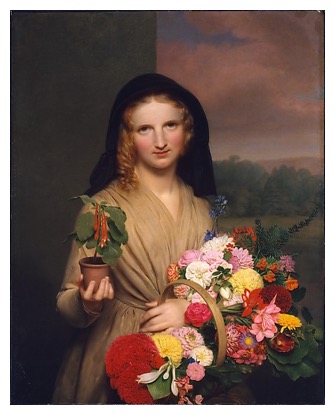
Fulgens – Brilliant; shiny or shining; glowing. F. fulgens, often called the “brilliant fuchsia” in older references, is native to Mexico where it was first collected around 1790 by the Mexican botanists, José Mariano Mociño (1757-1820) and Martín de Sessé y Lacasta (1751-1808), during the course of the ambitious botanizing campaign known as the Royal Botanical Expedition to New Spain (see also). This seminal expedition had been organized and directed by Sessé in various phases from about 1787-1803 and was undertaken with the financial support of the royal government in Madrid. At the end of the Expedition, the botanists journeyed to Spain to get support for the publication of the Expedition's work.
This quest was unsuccessful, however, and the invaluable collections, botanical illustrations and papers would become ignored and scattered due to war and political upheavals and remain published until posthumous attempts in Mexico in the 1880s. Mociño was forced to flee Spain in 1812 but managed to take some part of the work, on which he continued to labor after Sessé's death in 1808, into exile with him in France. In Montpellier, the physically declining Mociño met the Swiss botanist, Augustin-Pyrame de Candolle of Geneva, who utilized Mociño's notes and illustrations to describe and publish a number of new plants, including F. fulgens in 1828, in his Prodromus systematis naturalis regni vegetabilis.
Living material of F. fulgens, which often grows natively as an epiphyte or among rocks in moist areas, eventually made its way to Europe and the United States by about 1837. Plants or seeds were apparently collected by the French physician and botanist, Louis-Auguste Deschamps de Pas of Saint-Omer, on a trip to Mexico in about 1835-1836. In England, F. fulgens was acquired by the Lee Nursery of Hammersmith and rapidly distributed throughout the country from there. Europe saw a similar quick dispersal of Deschamps’ material.
The easily grown species instantly became fashionable in greenhouses and with florists, as evidenced by the many references and illustrations in widely disseminated horticultural publications of the period. It was almost immediately crossed with other fuchsias. There are a number of early hybrids, possibly with F. splendens, that are still often confusingly given as variations of the natural species. This is not surprising. Many early breeders used “var.” with abandon and cultivar names that mimicked actual species were common. The so-called “F. fulgens var. gesneriana” is only one such example. It's been speculated that many other garden hybrids are "probably of hybrid derivation from forms of F. magellanica and F. fulgens" (Bailey, Hortus, 264. 1930). As there are very few records of the actual parentage of most all early hybrids, this speculation must remain speculation, however logical. Perhaps genetic analyses will one day help in sorting out the mysterious parentages of fuchsia hybrids.
Ellobium fulgens (Lilja 1841), F. fulgens var. pumila (Carrière 1881), F. racemosa (Sessé & Moç. 1888) and Spachia fulgens (DC.) Lilja 1840) are all synonyms for this species.
See F. fulgens in ➤ Section Ellobium; also see ➤ Candolle, ➤ Ellobium, ➤ Mociño, ➤ Royal Botanical Expedition to New Spain, ➤ Sessé, ➤ Spachia.
(Illustration: The Flower Girl, Charles Cromwell Ingham, 1846. The Metropolitan Museum of Art, acc. no. 02.7.1.)
Furfuracea – Having a meal or scurf; having a flaky surface. See F. furfuracea (I.M.Johnst. 1925) in ➤ Section Fuchsia. No synonyms are recorded for this species.
Fusca – Brown, dusky. F. fusca (E.H.L.Krause 1906) is a synonym of F. decussata (Ruiz & Pav. 1802) in ➤ Section Fuchsia.
Fuschia – See ➤ Misspellings.
Fusia – Very occasionally seen spelling of fuchsia in Spanish. More common is ➤ fucsia.
Fusiform – Shaped like a fusil or spindle; tapering at each end.
Fuxia – Occasional alternative spelling for ➤ fucsia.
